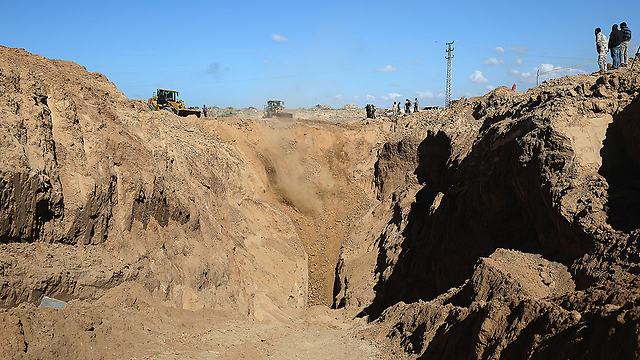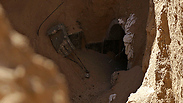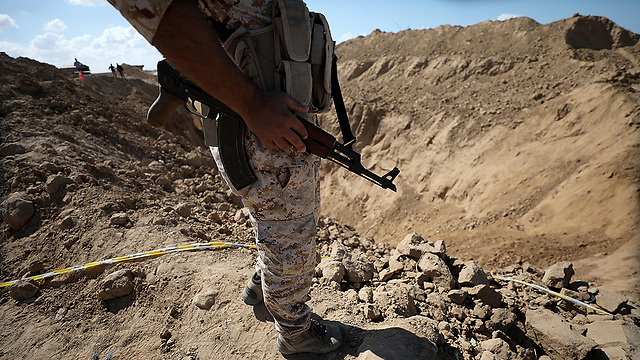
Is Gaza tunnel era coming to an end?
Analysis: Following the recent tunnel demolition, part of Gaza’s military leadership feels it would be illogical to keep investing huge sums in the tunnels now that Israel has effective ways of dealing with them, not mention the underground barrier being built along the border.
Chief of Staff Gadi Eisenkot’s main work directive to the IDF for 2018, the last year of his term, is to destroy all border-crossing tunnels—both those Israel is aware of and those it isn’t aware of yet—which have been dug or are being dug from the Gaza Strip into Israel.

Eisenkot was able to issue such an order due to the fact that three years after Operation Protective Edge, the army has obtained the technology and the means to allow an effective detection and destruction of tunnels in general and of border-crossing tunnels in particular.
The current tensions along the Gaza border, therefore, are not just the result of Islamic Jihad’s threats to avenge the demolition of its tunnel on October 30. Both Israel and the Palestinian factions in Gaza are flexing their muscles and growling in preparation for the day after the next border-crossing tunnel is destroyed.
The chief of staff’s order is clear: If a tunnel is uncovered, it will be destroyed. A tunnel will face the same fate as weapons smuggled from Syria to Hezbollah. And another tunnel will surely be uncovered. According to IDF assessments, since the destruction of 15 border-crossing tunnels during Operation Protective Edge, Hamas and Islamic Jihad have kept digging tunnels into Israeli territory. If there are diggings, and if there are effective detection means, there will be demolitions too. It’s just a matter of time.
Islamic Jihad is talking about revenge but is actually trying to create deterrence against Israel: To claim a sufficiently high price that would make Israel think twice before deciding to destroy the next tunnel.
Israel, on the other hand, is preparing for a disproportionate response to any attempt to violate its sovereignty. Alongside the preparations to defend Israeli residents, the Southern Command has likely also prepared a response that would target the other side’s weak points—from military leaders to military infrastrctures—and claim a high price that would be perceived by the other side as unbearable.
At the moment, Hamas is trying—with some success—to restrain Islamic Jihad and prevent it from implementing its plans. As far as Hamas is concerned, it is facing two critical tests: The planned opening of the Rafah Crossing on Wednesday, and the payment of salaries to government workers in Gaza by the Palestinian Authority on December 1. A flare-up could destroy the slim chance for progress in the Fatah-Hamas reconciliation process.
Islamic Jihad, however, is independent. The reports of the deployment of an Iron Dome battery in central Israel indicate the terror group is likely planning to fire rockets at crowded populated areas. It could fire mortar shells towards the communities near the fence or engage in sniper fire and anti-tank fire along the border. But the IDF and the population are apparently failing to provide Islamic Jihad with attractive targets thanks to the special deployment, so it is mainly left with high-trajectory fire into Israel.

The Hamas leadership should assume that if Israel knows how to locate and destroy offensive tunnels, it may also have an ability to locate the network of defensive tunnels (Photo: EPA)
Hamas is an organization that learns. It likely sees the uncovering and destruction of the tunnel as a significant event, which requires new thinking. The border-crossing tunnels are not just a key component in the terror organization’s offensive effort, but also a weapon of deterrence against Israel alongside the long-range rockets.
The realization that something on the Israeli side has changed began in early 2017: Israel has knowledge and new abilities. Today, after the tunnel demolition, part of the military leadership of Gaza’s terror organizations feels the tunnel era is coming to an end and that it would be illogical to keep investing huge sums in them now that Israel has an effective response to them, not to mention the underground barrier being built along the border as a response to the tunnels.
The Hamas leadership should assume that if Israel knows how to locate and destroy offensive tunnels, it may also have the ability to locate the network of defensive tunnels in Gaza, spanning tens of kilometers through the length and breadth of the strip. Gaza’s primary defense is based on those tunnels. If Israel reaches those tunnels as well, Hamas won’t only face financial bankruptcy, but a collapse of its military strategy as well.


















